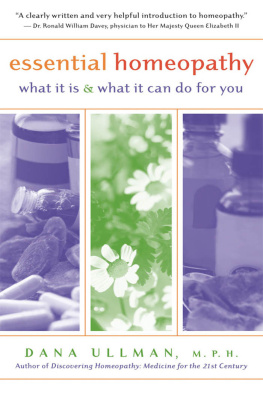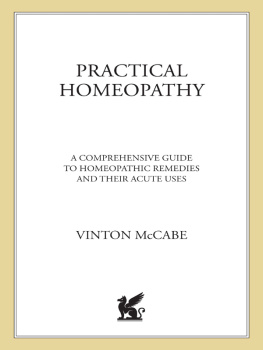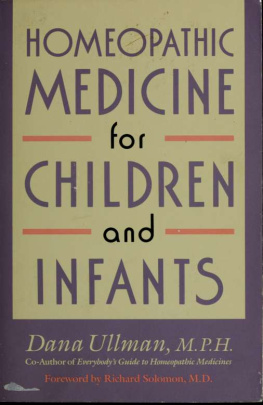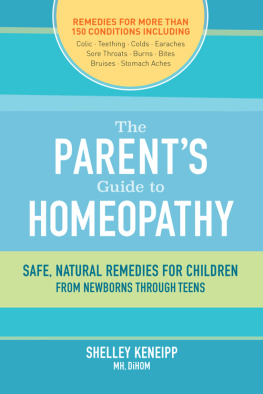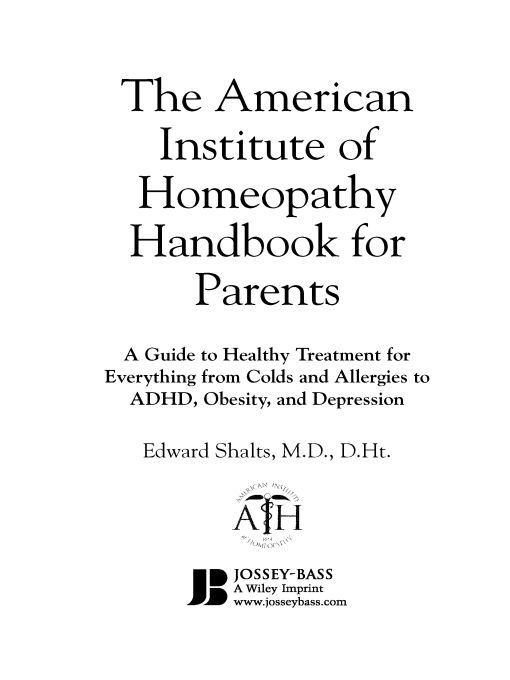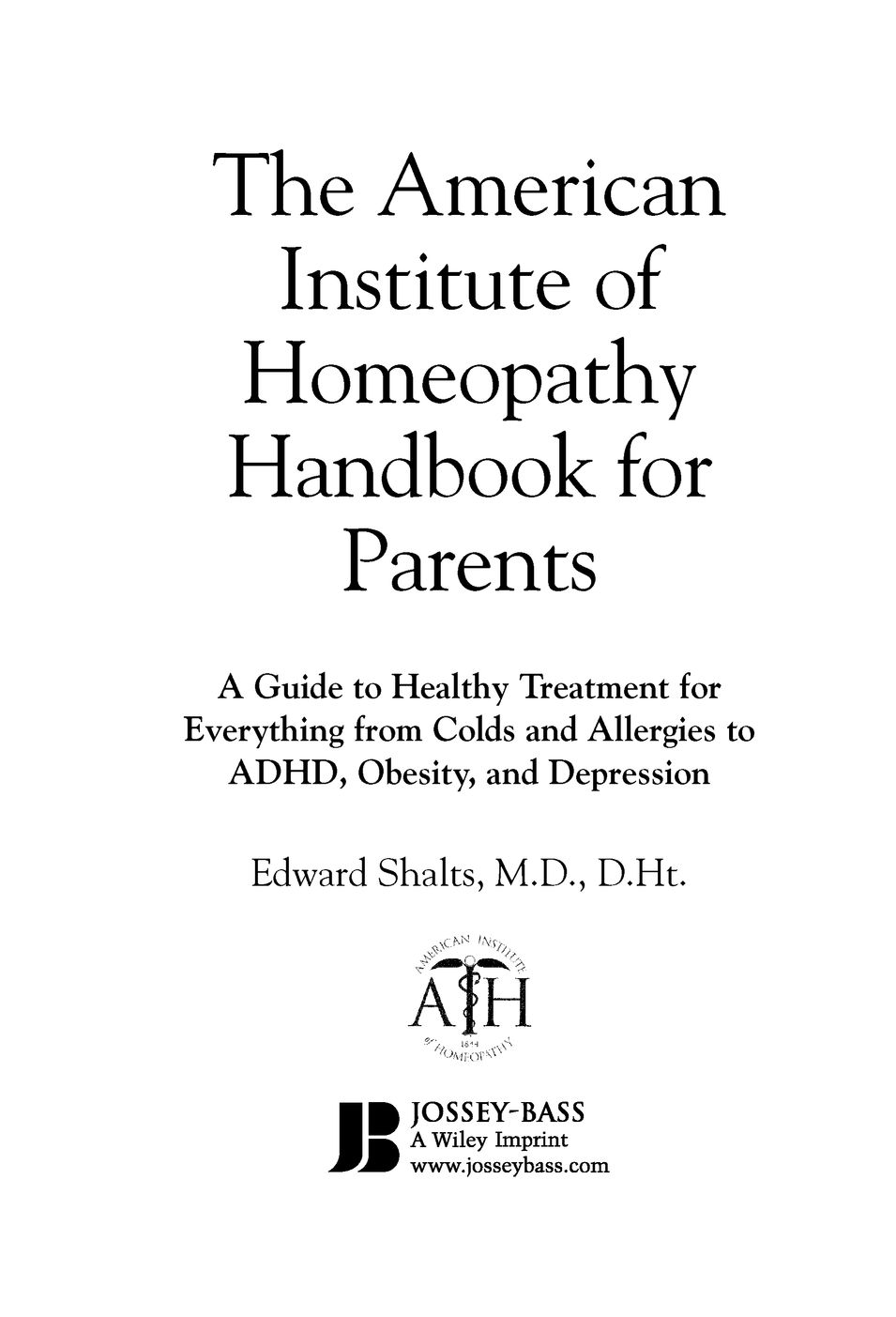Table of Contents
More Praise forThe American Institute of Homeopathy Handbook for Parents
Children will thank parents and pediatricians who read this book and use homeopathy as a safe and valuable method to treat their acute and chronic health problems. More important, Dr. Shalts informs parents that children with acute health problems who are treated and healed with homeopathy are more resilient and therefore less likely to develop a chronic illness.
Lawrence B. Palevsky, M.D., F.A.A.P., president, American Holistic Medical Association
Dr. Shalts accomplishes a great deal in one book. He presents a history of homeopathy, explains what to expect in a homeopathic interview, and delves into home treatment. The case descriptions are compelling and create a feeling as though Dr. Shalts is speaking to each parent individually. Great job!
Amy Rothenberg, N.D., D.H.A.N.P., and Paul Herscu, N.D., D.H.A.N.P., cofounders and principal instructors, New England School of Homeopathy
Dr. Shaltss Handbook has made homeopathy more accessible with its clear and concise description of the practical uses of this potent medical therapy. Effective for all ages and a wide range of illnesses, homeopathy can now be part of every familys home first-aid kit and part of every patients choice for treatment of many common conditions with this books recommendations.
Robert Schiller, M.D., chairman, Department of Family Medicine, Beth Israel Medical Center; assistant professor, department of family medicine, Albert Einstein College of Medicine; senior vice president, Institute for Urban Family Health
Edward Shalts is one of the nations most gifted homeopathic physicians. As an M.D. trained in both family medicine and psychiatry, he has written the definitive family guide to homeopathy, suitable for practitioners, consumers, and especially parents. This is a must-have reference guide in homeopathy.
Woodson C. Merrell, M.D., M. Anthony Fisher Director of Integrative Medicine, Continuum Center for Health and Healing, Beth Israel Medical Center; assistant clinical professor of medicine, Columbia University, College of Physicians and Surgeons
To my beloved daughters, Dora and Polina
Acknowledgments
First, I am grateful to Alan Rinzler at Jossey-Bass, who came up with the idea for this book and together with Catherine Craddock continually encouraged and supported the high quality of the editorial work. I would also like to thank production editor Carol Hartland, copyeditor Marcy Marsh, and marketing manager Jennifer Wenzel.
I am grateful to the board of trustees of the American Institute of Homeopathy for providing me with the opportunity to write this handbook on behalf of the organization. My sincere gratitude also extends to Rona Lichtenberg, who opened my eyes to the possibility of writing and encouraged me to take my first steps in this direction. The other person who constantly dreamed about my writing a book was my late father, Boris. I hope there is a way for him to celebrate this book with all of us, wherever he is at the moment.
Writing this book would not have been possible without the encouragement, nurture, and unconditional love that I constantly receive from my dear wife, Natasha. I also want to thank my daughters, Dora and Polina, for keeping the volume of our TV as low as they could during the writing process, and just for being there for me to love and admire. I appreciate all of the carbohydrates and other support provided by my mother, Emma.
I have the highest regard for the extraordinary writing, editorial, and organizational skills of Stephanie Gunning. Without her brilliant work, this book would not speak to readers in such an inviting and easy-to-comprehend language.
I truly appreciate the efforts and exceptional communication skills provided by Stephany Evans, my literary agent.
I am very grateful to Dr. Joyce Frye, Dr. Paul Herscu, and Dr. George Guess for reviewing this book and providing valuable suggestions. Special acknowledgment is also due to Paul Herscu and George Vithoulkas for providing me with important insights on the core issues of homeopathy.
I would like to thank Mr. Sow for all his support and Dr. Amy Rothenberg for helping me always to think about horses, not zebras, each time I hear hooves. Thanks also to Julian Winston for writing and publishing his great book, The Faces of Homeopathy, which made searching for information on the history of homeopathy so easy and a lot of fun.
Introduction
What Can Homeopathy Do for Your Children?
The American Institute of Homeopathy Handbook for Parents is designed to offer you a healthy alternative to conventional medical treatments for your childrens ailments.
Homeopathy is a medical specialty that uses natural substances, known as remedies, which are diluted and shaken in order to stimulate the bodys natural healing abilities. According to the principle of similars (discussed in Chapter One), which is the foundation of this approach, a substance that causes a combination of symptoms in a healthy, sensitive individual will cure similar symptoms in the sick. Homeopathy has been proven effective in the treatment of acute ailments, such as colic, fevers, and ear infections, as well as in the treatment of chronic diseases, such as asthma, depression, and allergies. Practitioners interview patients, usually for a few hours, in order to pinpoint the exact remedy thats needed. Homeopathy completely sidesteps the potential harms of more radical interventions.
Unlike conventional drugs, homeopathic remedies have a two hundred-year record of being able to provide individualized help and highly effective cures for many illnesses without causing any side effects or complications. They are also easy to use.
The Current Crisis
Numerous health experts in the United States and around the world warn that within a generationif left uncheckeda worrying trend of parents looking after sick children could increase even beyond its current alarming level. These days, in addition to traditional childhood diseases, our sons and daughters are being diagnosed too frequently with a variety of physical and mental health problems that include allergies, asthma, obesity, sinusitis, ear infections, attention deficit-hyperactivity disorder (ADHD), autism, and depression.
According to a report issued by the U.S. Surgeon Generals Office in 2000, the burden of suffering experienced by sick children and their families has created a major crisis. For despite widespread acknowledgment of these problems and many extreme efforts to treat them, childrens illnesses are still on the rise. Whatever were doing collectively to overcome this public health emergency is, frankly, not working.
Like a giant with legs made of clay, powerful conventional medications have failed to provide a universal answer to the growing epidemic of emotional and physical problems that our children are experiencing. Prozac and Ritalin have become cultural icons, illustrating both our desire to medicate children for expediency and the failure of our search for miracle drugs. Instead of being tools of last resort, many potent psychotropics, hormones, and antibiotics are used unreasonably often, and this has led to numerous side effects and unnecessary complications. In fact, drugs are now one of the most significant factors in an overall environmental assault on childrens health thats under way in our culture. Furthermore, because of the tremendous promise that doctors and parents hoped and believed these medications offered us, tremendous disappointment ensued when the anticipated miracle did not happen.


